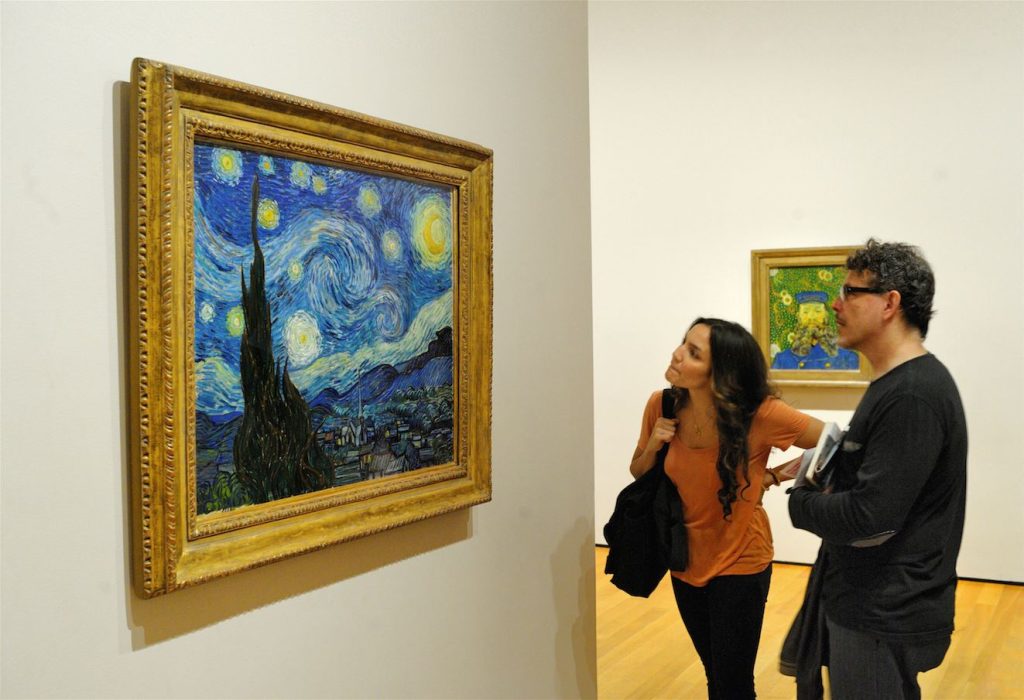We remain assured that there is nothing more mesmerizing than to look at the night sky. We stand by the limitless space; uncountable twinkling stars; and a cold breeze. These are the same feelings we experience when we look at the Starry Night painting. But who painted Starry Night? It was the famous Dutch post-impressionist painter, Vincent van Gogh. Despite being an idol in Western art, he never found appreciation for his art. Throughout his life, he battled depression and mental health issues, which informed several of his creations, including a Starry Night painting. His tumultuous life had been the subject of various essays, research articles, radio podcasts, documentaries and film – Loving Vincent.
Starry Night Painting
We know who painted the Starry Night. But when was Starry Night painted? Vincent van Gogh Starry Night painting was made in June 1889 during his time in the Saint-Paul-de-Mausole asylum in Saint-Rémy-de-Provence, France. He was voluntarily committed on account of self-mutilation (he cut off his left ear). The painting is an exquisite mix of vibrant yet melancholic blue. It features a swirling night sky filled with stars and Venus. Like many of his paintings, he has painted the cypress tree in the foreground. The (imaginary) village in the distance is also visible under the cosmic sky.

Vincent van Gogh Starry Night painting has been reproduced multiple times, occurring in several films, TV shows, and animated cartoons (even Courage The Cowardly Dog). The Starry Night real painting is currently housed in the Museum of Modern Art, New York. Even though Starry Night painting is the best known, van Gogh painted 21 night skies in total. They have come to be known as Starry Night sister paintings. These paintings include – ‘Starry Night over the Rhone’, ‘Road with Cypress Star’, and ‘The Café Terrace at Night’. These paintings were made in different weather conditions and lights. Even if they might contain numerous elements, the priority remains the night sky.
Starry Night Painting Meaning
The work is a testimony to his deteriorating mental health. While at the asylum, he was offered shelter from himself. He described his room in his painting The Bedroom (1888). From the window, he could see the floating irises and the cypress trees. However, no village was visible from his bedroom window and was added from memory. Van Gogh made around 2100 paintings, most of them during his later life (1888 – 1889), but the original Starry Night painting remains his biggest masterpiece; his magnum opus, even if van Gogh himself considered it as a ‘failure’.

Van Gogh Starry Night painting is an emotion in itself. It is extremely expressive and acknowledges the painter’s melancholy. Through bold colours and swirling forms, he describes the brightness in his life and the dissolving borders between reality and the abstract; a plea if you will. It is also renowned for its thick and dramatic impasto style – a unique feature of post-impressionism. The exceptional night sky consists of a crescent moon, a bright star (proved to be the planet Venus), and several stars (believed to be the constellation Aries). This throws the audience into a dreamlike state; a tête-à-tête with an otherworldly atmosphere. This personal interpretation is a delicate blend of realism and fantasy.

The cypress tree had been noted in many of his paintings. He had even mentioned them in the letters written to his brother Theo. In European culture, cypresses are associated with funerals. The flaming nature of the cypress tree in the Starry Night painting may be a nod to his culture, although it has never been proven. Despite many connotations by critics and fans alike, only van Gogh would know what went into painting Starry Night.
Image Courtesy – Wikipedia
Experience a walk under Vincent Van Gogh’s ‘The Starry Night’

Hi Ya’ll !!
I love writing about pop culture and all things queer.
Sub Editor at Abir Pothi





